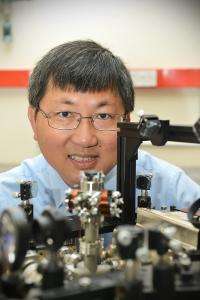Tiny, super cold atoms and the Earth's remaining oil sources

Ground-breaking space exploration technology is being used to develop an innovative new sensor for the subsea industry. Dr Charles Wang, an astrophysicist at the University of Aberdeen who is leading the development of the technology discussed his work at the British Science Festival today.
Devices used to measure the force of gravity in space are being adapted to help detect the presence of undiscovered oil and gas fields. Those behind the research say they aim to have a sensor which is being deployed by companies in subsea conditions within the next five years.
Dr Wang said: "The usual gravity we experience and understand is Earth's gravity, but in reality every object is a source of gravity.
"If you have a sensor with high enough sensitivity, it will pick up small gravitational changes which indicate the presence of an object. It is this technology which has been used for decades in the oil and gas industry to detect the existence of prospective oil fields."
So far this technology has proved too large and too power consuming to take underwater, and been limited to work above the sea level with companies using gravity measurements as part of their airborne survey work. Current research is working to develop a new sensor which will allow gravity measurements to be used, for the first time, in a subsea environment.
The key behind the research is the use of atoms like Rubidium.
Dr Wang continued: "When we cool these atoms to a super cold temperature and trap them in an atom cloud, it acts like a highly precise laser that can measure gravity in a way that is much more accurate than a normal optical laser could achieve. No mechanical parts are involved in the process so it is much simpler and more reliable."
The technology, known as a cold atom trap, was originally developed for an entirely different purpose – to measure gravity in space. It was created through a research project undertaken with Rutherford Appleton Laboratory Science and Technology Facilities Council. The project had a similar emphasis – to improve on technology currently available but in this case to better the gravitational technology being employed in space.
"Sensing gravity in space allows us to probe the subsurface formation structure in the Earth's crust and this can help us in our understanding of climate change and in analysing geological problems such as earthquakes by tracking continental plate movement and detecting fault lines" said Dr Wang.
"The European Space Agency launched a satellite called GOCE in 2009 which obtained the highest precision of gravity measurement yet to be achieved. The technology we are developing is expected to surpass this.
"It is this exact same science that we are taking from space and applying subsea – having seen the potential for the cold atom technology to be used subsea, and the massive consequences this could have in helping the industry find previously undetected hydrocarbons."
The sensor will also have the potential to be used in subsea pipeline inspection work - an area of critical importance given the sector's ageing pipelines.
Provided by University of Aberdeen




















